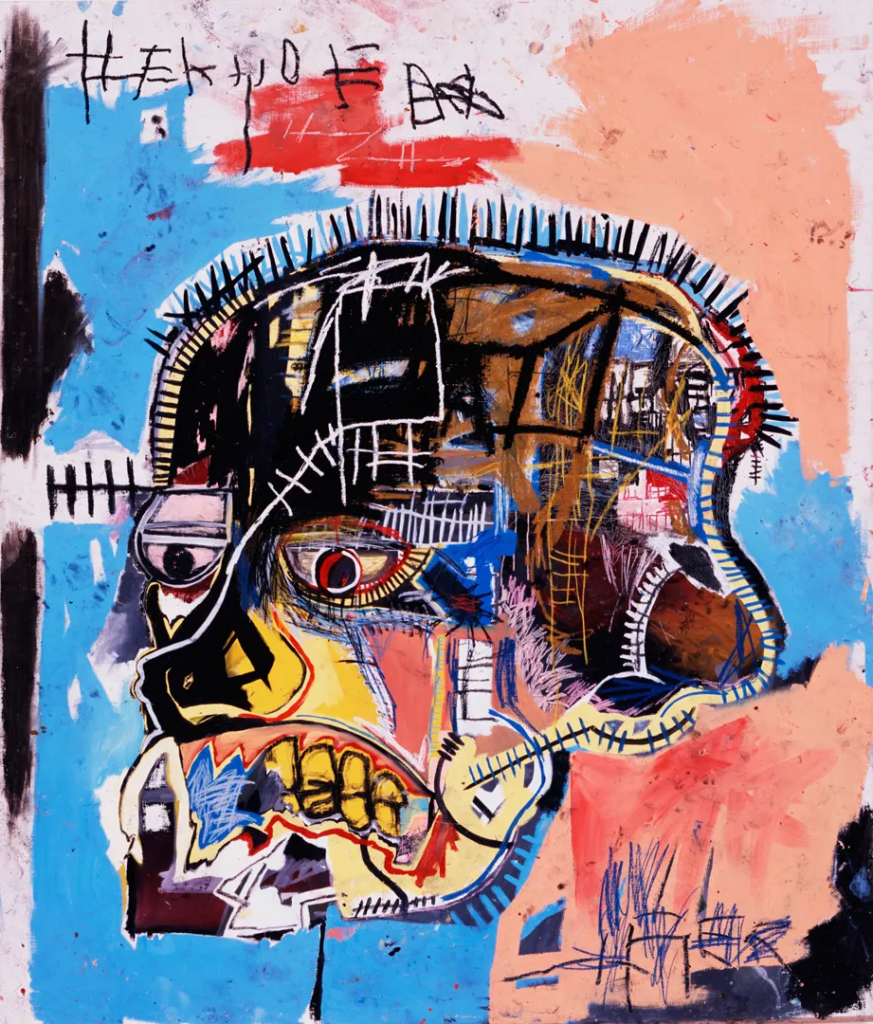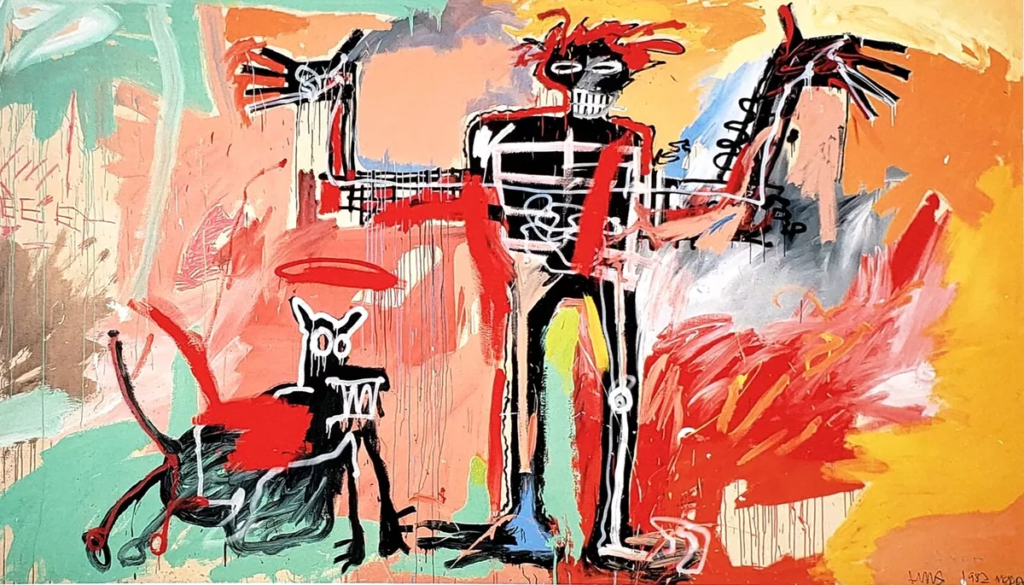Jean-Michel Basquiat is regarded as one of the most influential and iconic artists of the 20th century. Emerging from the vibrant streets of New York City, this extraordinary talent left a profound yet brief mark on the art world. Basquiat began his career with street art and quickly rose to the pinnacle of contemporary art, known for his works that questioned the social and political structures of society. In this article, we will explore Jean-Michel Basquiat’s life, art, and most important works.
Basquiat’s Life: From the Streets to Art Galleries
Jean-Michel Basquiat was born on December 22, 1960, in Brooklyn, New York. Born to a Caribbean family, Basquiat developed an interest in art at a young age. His father, Gerard Basquiat, was of Haitian descent, and his mother, Matilde Andrades, was Puerto Rican. Basquiat’s mother was the first person to encourage his interest in art. When he was five years old, she took him to the Brooklyn Museum, a visit that ignited his deep connection with art.
From an early age, Basquiat displayed remarkable intelligence; he learned to read and write by the age of four and by the age of six, he was fluent in three languages: English, French, and Spanish. However, behind this brilliance were tragic events. At the age of seven, he was involved in a car accident and was seriously injured. During his recovery in the hospital, his mother brought him a copy of “Gray’s Anatomy.” The medical illustrations in the book laid the foundation for the anatomical themes that would frequently appear in Basquiat’s later works.
The Rise of His Art: Pop Art and Neo-Expressionism
In the late 1970s, Basquiat began gaining attention by creating graffiti under the tag name SAMO on the streets of New York. SAMO, short for “Same Old Shit,” reflected his sharp and poignant messages against societal injustices and consumer culture. This period marked Basquiat’s initial steps into the art world.
By the early 1980s, his works began being exhibited in galleries, and he quickly garnered significant interest in the art world. Basquiat’s style was both aesthetically striking and rich in social commentary. His works addressed the history of Black people, identity issues, colonialism, and racism. Basquiat frequently combined childhood memories, popular culture, African-American heroes, and historical references in his works. His lines and figures, which blend both naive and fictional realities, stand out with a chaotic and energetic order.
Interesting Facts: The Many Facets of Basquiat
Basquiat’s life was as interesting and colorful as his art. For instance, after dropping out of school at a young age, he was homeless for a period and used cardboard boxes and other found objects as art supplies. During this time, he became a kind of “underground” icon in New York’s art scene.
During his rise in the art world, Basquiat met painter Andy Warhol in 1981, a meeting that became a significant turning point in his artistic life. Warhol took a great interest in Basquiat’s art, and together they produced several works. This collaboration marked a striking convergence of two different generations and styles. The friendship between Warhol and Basquiat brought new dimensions to the work of both artists.
Another area where Basquiat made a name for himself was music. In the early 1980s, he became closely involved with music and formed a noise rock band called “Gray.” This group performed at various venues in New York, and Basquiat’s connection with music also reflected in his works. He often expressed his admiration for jazz musicians in his art, carrying the improvisational and free spirit of jazz into his own creations.
His Most Important Works: Lasting Impressions in the Art World
Despite his brief career, Jean-Michel Basquiat left behind many iconic works. Here are some of Basquiat’s most important pieces:
1. Untitled (1981)

This piece is one of Basquiat’s early works and contains elements that define his unique style. The artwork features a face figure created with simple yet powerful lines. This figure is an early example of the human faces and skulls that frequently appear in Basquiat’s works.
2. Boy and Dog in a Johnnypump (1982)

This piece is one of Basquiat’s most well-known works and represents a significant turning point in his career. The intense use of colors and the dynamism of the figures demonstrate the energy and movement that often characterize his works.
3. Untitled (1982)

Created in 1982, this untitled piece was sold at auction in 2017 for $110.5 million, reaffirming Basquiat’s value as an artist. The work reveals Basquiat’s obsession with themes of death, identity, and humanity.
4. Hollywood Africans (1983)

This piece depicts Basquiat’s time spent in Los Angeles with his friends Al Diaz and artist Rammellzee. The work contains messages about the representation of Black people in Hollywood and issues of racism.
5. Horn Players (1983)

Basquiat had a deep admiration for jazz musicians. “Horn Players” pays tribute to jazz legends Charlie Parker and Dizzy Gillespie, highlighting the deep connection between music and art.
6. Charles the First (1982)

This piece is considered one of Basquiat’s most important and symbolic works. “Charles the First” is a tribute to Charles Mingus and also reflects his admiration for Black leaders. The words and symbols seen in the piece form a crucial part of Basquiat’s artistic language.
7. The Death of Michael Stewart (1983)

This work was created in memory of graffiti artist Michael Stewart, who was beaten to death by police in New York in 1983. The piece addresses the themes of police brutality and racial injustice, highlighting Basquiat’s social awareness.
8. Dustheads (1982)

“Dustheads” is one of Basquiat’s most powerful depictions of drug addiction. The figures in the piece are depicted in a chaotic and disturbing manner, reflecting the dark and destructive effects of addiction. This work became one of Basquiat’s highest-valued pieces, selling for $48.8 million in 2013.
9. In This Case (1983)

This piece is one of Basquiat’s skull-themed works and offers a powerful visual expression of human mortality. “In This Case” reflects Basquiat’s deep thoughts on life, death, and humanity.
10. Riding with Death (1988)

Completed shortly before Basquiat’s death, this piece openly expresses his thoughts on death. The work depicts a skeleton figure riding a horse, conveying the dark and hopeless state of mind that marked the final period of the artist’s life.
Basquiat’s Legacy: A Legend in Art
Despite losing his life at such a young age, Basquiat’s works and influence continue to live on. Basquiat became a legend in the art world and served as an inspiration, particularly for African-American artists. His works present a powerful narrative on racism, injustice, and social issues while also emphasizing the importance of originality and individuality in art.
Basquiat is recognized not only as an artist but also as a cultural phenomenon. His works continue to fetch record prices at auctions and are widely admired around the world. This legacy will forever enshrine Jean-Michel Basquiat as one of the greatest icons of modern art.


